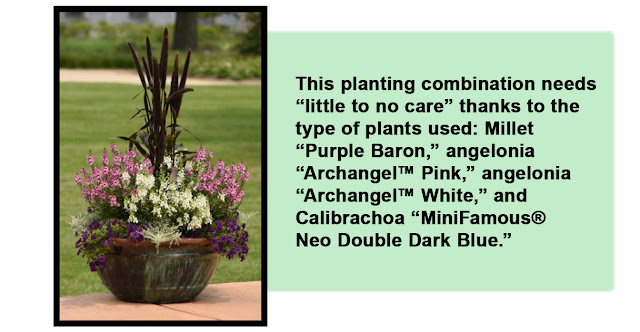Outdoor containers that look their best welcome texture and color from houseplants and perennials, too.
 |
| Cordyline fructicosa (Ti plant). |
When shopping for plants earlier this spring to pop into containers, I was reminded of a conversation with Joan Mazat.
Joan, Head of New Product Development for Ball Ingenuity, said when choosing a plant for your container designs, it's important to use a plant for the qualities it offers – either bright bold flowers or foliage for texture – and disregard the boundaries that we subconsciously group plants into.
For example: using houseplants outdoors.
"Pothos can go outdoors," she joked. "The standard pothos lives in tropical areas, and would be as tall as a tree if you let it be in the tropical environment where it is happy."
As Joan showed me some of her container designs (more on that, below), I noticed one relied solely on perennials.
It's almost laughable that I pointed out the obvious: "You're placing a perennial in a summer container?"
"It's about looking at the whole picture to see what will work," Joan explained. "If the plant gives me the growth and texture I'm looking for, I'll use it."
Perennial or houseplant – doesn't matter. Annuals shouldn't get all the attention. If the plant meets the sun/shade criteria, soil needs, etc. – it's a key candidate.
"The barriers are in the mind," she said. "It's not the plant telling you it can't be in the container."
Seeking candidates for containers
Each year Joan creates container combinations that will add curb appeal but won't take a lot of time to care for.
Joan has been designing unique and "honey, stop the car" container combinations for 23 years. Many of the container creations she designs for Ball are planted in May and are evaluated in August to see how the plant looks during the hottest months. The plants are also evaluated for their amount of required care to perform well – and the team does not "baby them" throughout the growing season.
When looking for a container to house your large plant combinations, look for pots that are at least 14 inches in diameter or larger. The larger pot will provide more room for the plants to grow throughout the season (both foliage and roots).
For heavy pots, move it into the desired location before you begin planting to minimize the need for moving it around the garden at a later time. (For large, heavy containers that I do need to eventually move in the garden, I use my hand truck to move them about.)
Large pottery is an investment for your garden, so look for glazed containers labeled as frost proof for colder climates. If possible, bring them into an unheated garage for the colder season.*
Consider different pairings
As mentioned earlier, Joan's perennial combination was a definite standout.
"Foliage has gotten more popular," she said. "Look at the leaves on "Carnival Rose. This texture is not achievable with annuals."
Image text: Joan’s perennial design includes “Carnival Rose Granita” heuchera, “Flutter Deep Blue” scabiosa, “Carnival Cocomint” heuchera and “Sparkle White” gaura. Photo used with permission: Ball Container Solutions.
For the blue container
Cobalt blue and navy glazed pots have been regularly available for gardeners in the Northeast U.S. for several years. I asked Joan which plants she recommended that would pair well with blue pots. One combination utilizes begonias ("the Whopper is indestructible") along with the Kimberly Queen fern, which can take more sun than other varieties.
style="text-align: left;">Image text: For shade to partial shade, Joan recommends pairing 'Kimberly Queen' fern, with Begonia 'Mistral Orange' and 'Whopper Rose with Bronze Leaf.' The colorful flower combinations of the begonias provide a pop of color for the darker corner. Photo used with permission: Ball Container Solutions. |
For the pastel palette
These are just a few plant combinations to get you inspired. When choosing plants to go into containers, read the plant tag to find out the recommended lighting requirements and growth habits. Look for keywords such as "compact" or "vigorous" when used to describe the plant, she said.
"If a plant has an 8 inch spread, don't pair it with a 36 inch spread in the same container," she said. (The two will compete and eventually the larger spreading one will take over.) Employees of independent garden centers can also point you in the right direction for appropriate plant partners.
* * *
Back to my earlier shopping trip.





No comments
Post a Comment